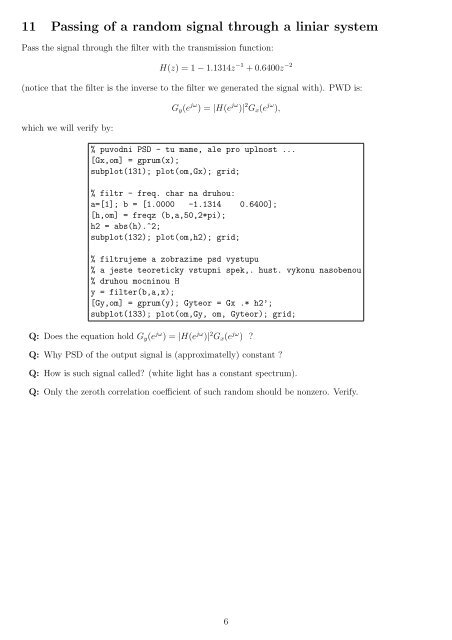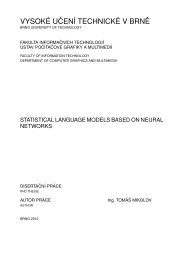Random Processes – Fundamentals 1 Generation of a Random ...
Random Processes – Fundamentals 1 Generation of a Random ...
Random Processes – Fundamentals 1 Generation of a Random ...
You also want an ePaper? Increase the reach of your titles
YUMPU automatically turns print PDFs into web optimized ePapers that Google loves.
11 Passing <strong>of</strong> a random signal through a liniar system<br />
Pass the signal through the filter with the transmission function:<br />
H(z) = 1 − 1.1314z −1 + 0.6400z −2<br />
(notice that the filter is the inverse to the filter we generated the signal with). PWD is:<br />
which we will verify by:<br />
Gy(e jω ) = |H(e jω )| 2 Gx(e jω ),<br />
% puvodni PSD - tu mame, ale pro uplnost ...<br />
[Gx,om] = gprum(x);<br />
subplot(131); plot(om,Gx); grid;<br />
% filtr - freq. char na druhou:<br />
a=[1]; b = [1.0000 -1.1314 0.6400];<br />
[h,om] = freqz (b,a,50,2*pi);<br />
h2 = abs(h).^2;<br />
subplot(132); plot(om,h2); grid;<br />
% filtrujeme a zobrazime psd vystupu<br />
% a jeste teoreticky vstupni spek,. hust. vykonu nasobenou<br />
% druhou mocninou H<br />
y = filter(b,a,x);<br />
[Gy,om] = gprum(y); Gyteor = Gx .* h2’;<br />
subplot(133); plot(om,Gy, om, Gyteor); grid;<br />
Q: Does the equation hold Gy(e jω ) = |H(e jω )| 2 Gx(e jω ) ?<br />
Q: Why PSD <strong>of</strong> the output signal is (approximatelly) constant ?<br />
Q: How is such signal called? (white light has a constant spectrum).<br />
Q: Only the zeroth correlation coefficient <strong>of</strong> such random should be nonzero. Verify.<br />
6







